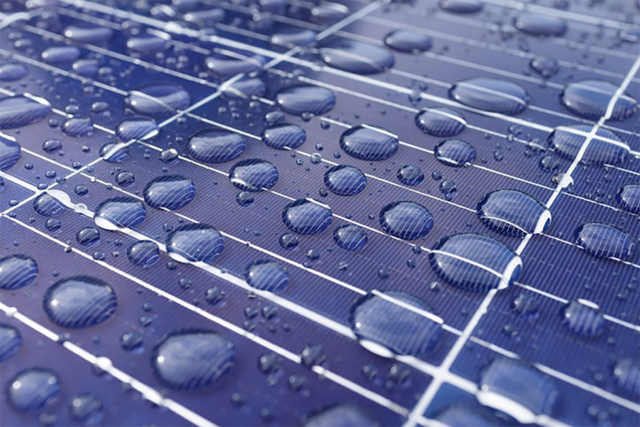The Evolution of Stormwater Management on Solar Developments

What Has Changed and What Is to Come
As solar development has exploded across the United States, so has the uncertainty for the analysis of solar developments with respect to stormwater management.
Many of the stormwater management ordinances adopted by Authorities Having Jurisdiction (AHJ’s) were created in response to the Clean Water Act of 1972 and subsequent environmental regulations. These ordinances were written largely to address more traditional development (i.e., buildings, impervious parking areas, etc.), with the understanding that the soils beneath these improvements are unable to infiltrate any rainwater from the impervious surface above it.
Separate from traditional development, elevated solar panels typically allow for the infiltration of rainwater below them. This has raised a series of questions from solar developers and stormwater reviewers alike, such as:
- Should the solar panels be treated as impervious surfaces?
- Should only the solar panel foundations be treated as impervious surfaces?
- Is the flow path of rainwater along the dripline of the arrays like that of pre-development sheet flow?
As anticipated, the response to these questions from developers versus that of plan reviewers vary. Some developers argue that no stormwater management requirements are needed at all, especially if the access roadways were permeable; while plan reviewers have pushed back, responding that the installation process alone would influence the hydrologic characteristics of a site.
LaBella Civil Engineer, Jared Pantella, PE, breaks down the evolution of stormwater regulations from Maryland, North Carolina, Pennsylvania, Virginia, and Ohio over the last seven years, highlighting where these regulations stand today and what to expect should they make their way to your state.
Maryland
In January of 2013, Maryland Department of the Environment issued Stormwater Design Guidance for solar panel installation. The guidance emphasized that nonstructural techniques were a low-cost alternative to treating runoff from narrower impervious areas (including solar panels) by promoting overland filtering and infiltration. Albeit certain conditions needed to be met to take credit for the impervious disconnects, such as:
- The vegetated area receiving the runoff must be equal to or greater than the disconnected impervious surface.
- Runoff must sheet flow onto and across vegetated areas to maintain the disconnection.
- Disconnections should be located on gradual slopes (< 5%) to maintain sheet flow. Slopes between 5% and 10% can be addressed via level spreaders, terraces, or berms but slopes greater than 10% will require an engineered plan to ensure a non-erosive conveyance.
- Disconnections work best in undisturbed soils.
- Groundcover vegetation must be maintained in good condition in those areas receiving the runoff.
Once solar developers caught wind of the Maryland Guidance, it was quickly brought to the attention of other AHJ’s, including those outside of Maryland. Some localities accepted the Maryland Guidance while others still enforced the traditional-development models showing solar panels as impervious coverage.
It’s worth mentioning that the Maryland Guidance is prefaced by the callout of the state’s stormwater regulations requiring ESD to the MEP (Environmental Site Design to the Maximum Extent Practicable). The guidance also mentions that the disconnect method may address “some or all” of the stormwater management requirements of the project.
North Carolina
Four years later in April of 2017, the North Carolina Department of Environmental Quality published a section in their Stormwater Design Manual focused specifically on solar farms. The section includes six design recommendations for stormwater management. The recommendations brought additional considerations to light as compared to the Maryland Guidance published years earlier.
The recommendations included:
- Avoid compaction of subsoil.
- Disconnect runoff from solar panel arrays.
- Avoid Concentration of stormwater.
- Minimize the use of herbicides and fertilizers.
- Plant a mix of warm- and cool-season grasses.
- Limit vertical clearance to < 10 feet.
Pennsylvania
Fast forward two years to January 2019, when the Pennsylvania Department of Environmental Protection (PA-DEP) issued a FAQ sheet on the Permitting of Solar Panel Farms for Erosion and Sediment Control and Stormwater Management.
The PA-DEP FAQ sheet, possibly the most robust publication listed thus far, goes from the basics; yes, the project is subject to E&S Control if you disturb more than 5,000 sq. ft.; yes, the project is subject to SWPPP and NPDES requirements if your project disturbs 1 acre or more, etc., but also dives into the finer details.
Five new and significant points discussed in the PA-DEP publication include the following:
- The post-construction condition should have a minimum uniform 90% perennial vegetative cover with a density capable of resisting accelerated erosion and sedimentation. This differs from the standard PA requirement of 70% perennial vegetative cover since the vegetation functions as the primary PCSM BMP (Post Construction Stormwater Management Best Management Practice) for the solar farm.
- The disconnection length utilized in the PCSM calculations extends from the panel drip edge to the next panel drip edge (at a minimum this is 2 times the length allowable in prior jurisdictions).
- Projects that need grading within array areas with slopes between 10-15% may be acceptable upon site evaluation and certification by a qualified professional engineer and the addition of slope protection, if necessary.
- The project should minimize the vertical clearance of the solar array from the ground, utilizing additional controls to address accelerated erosion where the lowest vertical clearance exceeds 10 feet.
- If the solar panel support structure/foundations result in more than 5% of the project site area, the applicant will be required to conduct a stormwater analysis in accordance with standard NPDES requirements.
The PA-DEP FAQ Sheet provides comprehensive direction for both solar developers and stormwater review agencies to adhere to, possibly due to the available research data on solar development within the US.
At this point, one can start to see the patterns developing among the stormwater management requirements throughout different jurisdictions.
Virginia
With the passage of the Virginia Clean Economy Act of 2020, Virginia ranked within the top 4 states for solar development in 2021. Extending into 2022, Virginia had over 1,000 MW of solar development installed annually to date. Virginia’s Permit-By-Rule (PBR) process, which required local jurisdictions to meet with solar developers once a siting agreement request was received, made the Commonwealth a magnet for solar developers around the country. The Commonwealth’s Stormwater Management Program (VSPM) only helped unleash the floodgates for even more development.
Prior to 2022, ground-mounted solar installations subject to the VSMP were not required to include the imperviousness of the solar panels when applying the Commonwealth’s post-development stormwater management criteria. It did, however, require the area of the foundation piles/helix screws to be calculated and modeled as impervious coverage.
The Commonwealth later determined that this method underestimated the post-development runoff/rate from solar panel arrays, which in-turn had a negative impact on downstream property owners. Another fact that didn’t help the Commonwealth was the Chesapeake Bay Program, which has coordinated the restoration of the Chesapeake Bay and its watershed since 1983, considers solar panels to be impervious as related to modeling and calculations for the Chesapeake Bay Total Maximum Daily Load (TMDL).
Understanding that water quantity (rate/volume) and water quantity (TMDL/Nutrients) are two separate aspects of stormwater management, this default fact was used to justify the following.
On March 29, 2022, Virginia’s Department of Environmental Quality (DEQ) issued a memo that the following directives should be integrated into ground-mount solar installations with respect to stormwater management:
- Quantity: Solar panels are to be considered unconnected impervious areas when performing post-development water quantity calculations.
- Quality: Solar panels are to be considered impervious areas when performing post-development water quality calculations using the Virginia Runoff Reduction Method (VRRM). The panel area may be considered a “simple disconnection” for these calculations.
- Alternative Methods of meeting stormwater quantity and quality requirements are not prohibited.
The memo was made effective immediately, illustrating that “the policy applies to all stormwater management plans not approved prior to the date of this memorandum regardless of the stage of design.” And on April 14th, 2022, DEQ issued a clarification memo stating that the former memo was only subject to “any project(s) that does not obtain an interconnection approval by a regional transmission organization or electric utility by December 31, 2024.”
Ohio
In April of 2022, the Ohio EPA Division of Surface Water published the final draft of the Buckeye state’s “Guidance on Post-Construction Stormwater Management for Solar Panel Fields”. The guidance mimics that of PA-DEP’s FAQ sheet, just in a less comprehensive manner.
Some noteworthy differences between the guidelines included a requirement of a short-term vegetation establishment period (first two years) to ensure that the vegetation would effectively control stormwater both immediately after construction and long-term; and an actual limit specified for construction vehicle axle loading allowed to work within disconnection areas prior to the need of soil tilling (axle load limit = 6 tons).
Sure, there are still the rogue localities out there treating solar panels as impervious coverage requiring rate and volume analysis, but for the most part, the requirements are similar. Keep the row spacing equal to or greater than the table width, keep the grasses native and healthy, no heavy equipment on the disconnect areas, and don’t put the panels too high.
Thankfully, due to the collaboration of multiple states and agencies throughout the east coast, the stormwater requirements for solar panel installation throughout the remainder of the US will be relatively easy to predict.
For more information on how LaBella can help with your solar development needs, contact renewables@labellapc.com

About the Author
Jared Pantella, PE, PLSCivil Engineer, Regional Leader
Jared has 15 years of combined formal education and technical experience in the fields of civil engineering and surveying. His roles have included Survey Field Crew Leader, Civil Designer, Civil Engineer, Project Manager, and Senior Project Manager. With a focus in design-build project delivery, Jared specializes in renewable energy, power generation, heavy industrial, and commercial projects. His experience in survey, site development, stormwater management, and erosion and sediment control is key for civil design and permitting. Based in Frederick, MD, his geographical footprint extends from New York to Virginia.